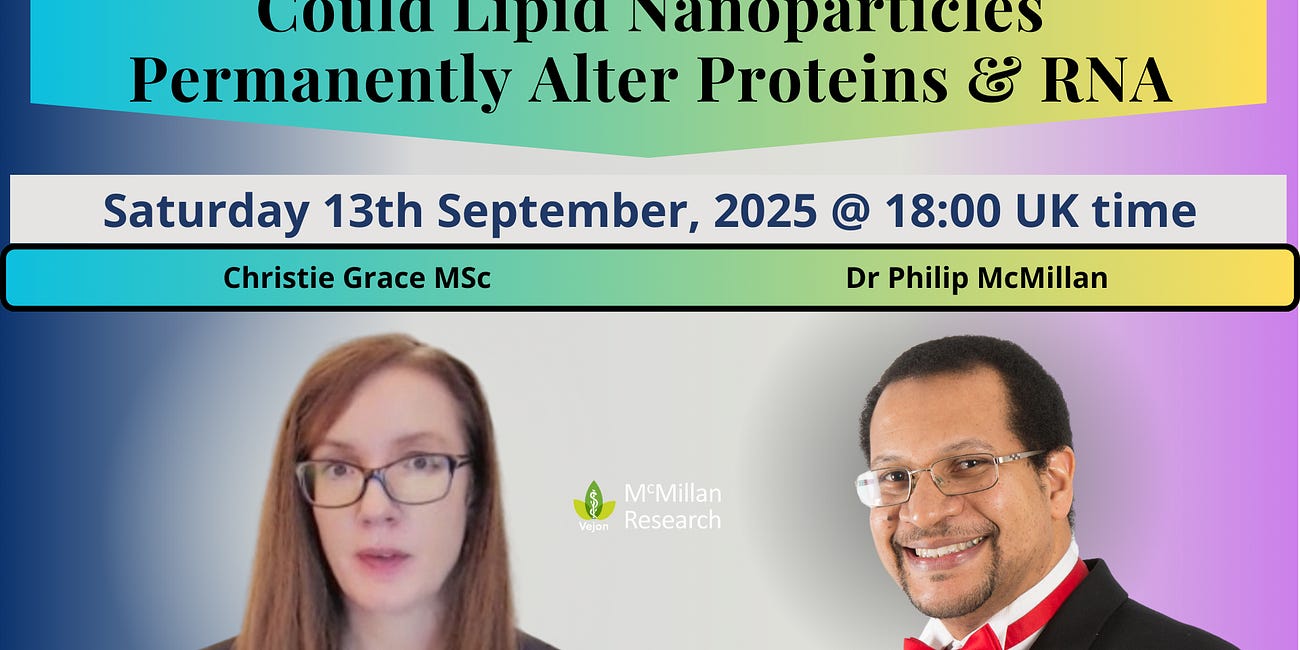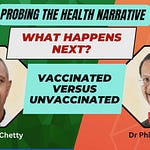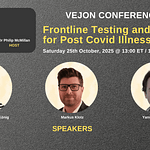When I first spoke with Christie Grace, I didn’t expect the discussion to shake me quite so deeply. She isn’t a social media pundit or a headline chaser — she’s a biotech professional who spent years working with modified RNA, lipid nanoparticles, and gene therapy platforms. Her background spans project and process management in biotech, designing recombinant proteins and supporting research teams developing therapies for genetic diseases and cancer.
That experience gives her a front-row seat to how these technologies work — and, more importantly, how they’re supposed to be tested.
A Sensitive Conversation
Our first conversation about mRNA–LNP safety was heavily censored online. That in itself raised a red flag for me.
When difficult scientific questions are met with silence or suppression, it usually means we’ve hit something important.
So when Christie agreed to come back for a follow-up discussion, I knew we were venturing into controversial territory. This wasn’t about undermining vaccines. It was about asking: Have we really done the right kind of testing for this new technology?
The Fatal Flaw in mRNA: How Lipid Nanoparticles Could Take Down the Platform
When I first began looking into the hidden chemistry of mRNA technology, I expected complexity, but I did not expect to find evidence that could shake the foundations of the entire platform (timecodes below).
The Central Question
Christie’s recent preprint paper, “Regulatory Assessment Gaps and Genotoxicity Considerations in mRNA–LNP Technologies,” outlines a disturbing possibility:
The tests used by regulators to assess DNA safety for mRNA vaccines — namely, the Ames test and micronucleus assay — are not structurally or mechanistically capable of detecting the real risks associated with lipid nanoparticle formulations.
In simple terms:
The Ames test uses bacteria to see if a compound mutates DNA. But the lipid nanoparticles used in mRNA vaccines are too large to enter bacterial cells, making the test meaningless.
The micronucleus assay uses resting lymphocytes (PBMCs), but these cells don’t absorb nanoparticles. So again, the test can’t reflect what actually happens inside the human body.
Christie’s point is not that the vaccines are genotoxic — but that the current testing regime is incapable of proving that they’re not.
DNA Plasmids, Lipid Adducts, and Unanswered Questions
During our conversation, Christie explained that vaccine production can leave behind fragments of linearized plasmid DNA — small pieces of genetic material used in the manufacturing process.
Normally, these should be destroyed or filtered out, but recent studies (including one co-authored by Kevin McKernan and colleagues) have detected measurable levels in finished vaccine vials.
The concern isn’t theoretical.
If these DNA fragments are carried into cells within lipid nanoparticles — which are designed to help genetic material enter cells — they could interact with human DNA, especially during cell division when nuclear membranes are temporarily open.
To make matters more complex, the ionizable lipids used in the LNPs are positively charged and can form covalent bonds (“adducts”) with negatively charged RNA or DNA. Moderna itself confirmed this chemical behavior in a 2021 study — yet no follow-up in human or animal systems appears to have been done.
As Christie put it,
“They found the adducts. They knew they were forming covalent bonds. But no one tested if it happens in human cells. It’s like waving a metal detector over a suitcase and saying, ‘See? No danger here.’”
A Failure of Oversight
When Christie went looking through official documents, what she found was even more concerning.
In Moderna’s Safety Data Sheet, the section on genotoxicity states plainly:
“No data is available for this product or other chemically similar mRNA vaccines using the same LNP platform.”
The few studies cited were done not on the full vaccine formulation, but only on the isolated lipid component — tested against bacteria and resting immune cells that cannot absorb nanoparticles.
In other words, the system gave a “clean bill of health” for tests that could never have shown anything meaningful in the first place.
It’s not that regulators were malicious. It’s that the rules they relied on were outdated, written for small molecules and attenuated viruses, not for nanoparticle-delivered genetic material.
The Call to Action
Christie’s preprint is available here.
If you believe in open scientific dialogue, read it, share it, and let your representatives and regulatory agencies know that citizens expect full transparency when it comes to genomic safety.
The Ethical Question
One of the hardest moments in our talk came when we discussed ethics.
Billions of doses of mRNA vaccines have been administered worldwide. The industry argument is simple: if there were a major genotoxic issue, we’d have seen it by now.
Christie disagrees. She points out that certain effects — especially genomic ones — might only become evident over long periods, and that the FDA’s own 2020 guidance on gene therapies called for up to 20 years of monitoring for potential DNA integration or latency.
Her frustration is palpable:
“For agencies to stock themselves with people who call themselves experts, and then not test what the chemistry itself shows could happen — that’s not science. That’s negligence.”
And she’s right to note that this isn’t just about COVID.
The same mRNA–LNP platform is now being used for influenza, RSV, HPV, and even cancer vaccines — yet the same outdated testing logic applies.
Where Do We Go From Here?
Neither Christie nor I are suggesting we abandon mRNA technology.
In fact, both of us see its enormous potential — particularly in treating devastating genetic conditions where few options exist.
But using that same high-risk, high-reward platform for mass vaccination of healthy populations is a different matter altogether.
The pandemic emergency justified acceleration; the post-pandemic era demands accountability.
If these tests were skipped because of time pressure, fine. But now that the urgency has passed, the proper genotoxicity studies must be done — transparently, independently, and publicly.
My Reflections
What struck me most was not the chemistry or the technical arguments — it was the pattern.
Each time someone raises a mechanistic concern, the answer isn’t “We tested it and it’s fine.”
The answer is “We didn’t have to test it.”
That, to me, is unacceptable.
Public trust in science can only exist when every obvious question has been asked — and answered honestly.
So I’m sharing this conversation not as proof of harm, but as a call for scientific humility.
If the data show there’s no genotoxic risk, that’s wonderful news. But until those data exist, the claim of safety remains unproven.
Timecodes
00:00 – Introduction: Why this conversation matters
Dr McMillan explains the background, censorship of the first discussion, and why this follow-up is urgent.
01:45 – Who is Christie Grace?
Christie introduces her biotech experience in RNA, CRISPR, and recombinant protein development.
03:50 – Did regulators really understand mRNA technology?
A candid look at how new these platforms were to most agencies before COVID-19.
05:30 – Is mRNA therapy the same as a vaccine or gene therapy?
Christie explains why it fits neither category perfectly and why definitions matter for regulation.
07:30 – Can mRNA or plasmid DNA enter the cell nucleus?
Discussion of cellular barriers, nuclear pores, and when entry could occur.
09:30 – The issue of plasmid DNA contamination
Christie cites studies showing residual plasmid DNA and explains why its presence matters.
12:00 – Lipid nanoparticles and charged interactions
Exploring how ionizable lipids bind to RNA and DNA — and why this chemistry could alter stability.
14:00 – Do plasmids and modified RNA really break down?
Evidence from animal and human studies suggesting prolonged persistence of genetic material.
16:30 – Industry response: “Billions of doses, no signal”
Dr McMillan poses the pharma defense; Christie responds with examples of safety signals and FDA guidance.
20:30 – How the tests were actually done
Breakdown of Moderna’s safety data sheets and why Christie says the assays were “mechanistically irrelevant.”
24:30 – Regulators vs. manufacturers: passing the buck
Both sides blame each other for not requesting or performing full genotoxicity tests.
27:30 – Should mRNA technology be used for routine vaccines?
Discussion of emergency use versus mass vaccination of healthy populations.
31:00 – The new paper and what it reveals
Christie describes her preprint findings from global regulatory documents.
36:30 – The ethical responsibility to re-test
Why transparency and new genotoxicity studies are essential before expanding the platform.
44:00 – How the public can act
Viewers urged to read, share, and send the paper to policymakers and regulators worldwide.
52:00 – Final reflections and call for scientific integrity
Closing thoughts from both speakers: doing the proper tests protects both public trust and future biotechnology.
Vejon COVID-19 Review is a reader-supported publication. To receive new posts and support my work, consider becoming a free or paid subscriber.










